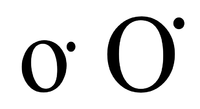O͘
O͘ is one of the six Taiwanese Hokkien vowels as written in the Pe̍h-ōe-jī (POJ) orthography. It is a normal o followed by Unicode U+0358 ◌͘ COMBINING DOT ABOVE RIGHT, and is not to be confused with the Vietnamese Ơ. It is pronounced [ɔ].

This letter is not well-supported by fonts and is often typed as either o· (using the interpunct), o• (using the bullet), o' (using the apostrophe), oo, or ou.
Because Taiwanese is a tonal language the standard letter without a diacritic represents the vowel in the first tone, the other five possible tone categories require one of the following tonal symbols to be written above it.
- Ó͘ ó͘ (second tone)
- Ò͘ ò͘ (third tone)
- Ô͘ ô͘ (fifth tone)
- Ō͘ ō͘ (seventh tone)
- O̍͘ o̍͘ (eighth tone)
History
The character was introduced by the Xiamen-based missionary Elihu Doty in the mid-nineteenth century, as a way to distinguish the Minnan vowels /o/ and /ɔ/ (the latter becoming ⟨o͘⟩).[1] Since then it has become established in the Pe̍h-ōe-jī orthography, with only occasional deviations early in its usage – one example being Carstairs Douglas's 1873 dictionary, where he replaced the ⟨o͘⟩ with an o with a curl (similar to that of the English Phonotypic Alphabet),[2] and a second example being Tan Siew Imm's 2016 dictionary of Penang Hokkien, where she replaced the ⟨o͘⟩ with ⟨ɵ⟩.[3]
References
- Klöter, Henning. "The History of Peh-oe-ji" (PDF). Archived from the original (PDF) on 2011-05-29.
- Douglas, Carstairs (1990) [1873]. Chinese English Dictionary of the Vernacular or Spoken of Amoy. Taipei: Southern Materials Center. ISBN 957-9482-32-2.
- Tan, Siew Imm (2016). Penang Hokkien-English Dictionary. Areca Books. Retrieved 21 August 2019.